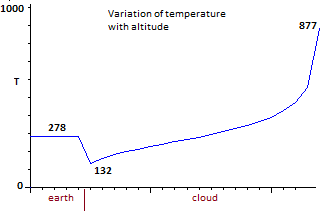Some 30+ years ago I used to be a university researcher into heat flow in buildings. We constructed models of heat flow through walls, ceilings, floors, windows.
But we didn’t consider the environment outside the buildings. We didn’t build models of the atmosphere.
Nevertheless, ever since climate models became a source of contention over global warming (or the lack of it), I’ve always wanted to extend my heat flow models to include the atmosphere.
And I’ve had several tries at doing so, which were mostly unsuccessful. Because I’ve yet to come across an explanation of how to do it. Although I have come across a few people who have been building very complex models.
So it all rather ground to a halt. Until a few weeks ago, that is, when I decided it might be worth building a very simple atmospheric model from first principles, ignoring everything I knew (or rather, didn’t know) about Earth’s atmosphere.
I’ve recently been building simulation models of rock clouds, and so I thought that maybe I could think of an atmosphere as being made up of lots and lots of little rocks in orbit around the Earth. There’d be no ‘air’, no ‘wind’, no ‘air pressure’, no ‘adiabatic lapse rate’ or any of the other stuff meteorologists talk about. There’d just be lots of rocks in empty space. There’d be a dust cloud.
And the dust would be found in layers above the surface of the Earth, and would be heated by sunlight filtering down through the layers to the surface of the Earth. At each layer, sunlight would either pass through the layer, or else would strike dust particles. And when sunlight struck a particle, it would either be reflected back up, or absorbed by the particle, warming it up. And as the dust warmed up, it would radiate heat upwards and downwards.
Now there would be a lot of sunlight and radiated heat bouncing around inside this dust cloud. There’d be multiple reflections between layers. But once a ray of sunshine was admitted at the top of the cloud, it would all end up somewhere or other. It would either be absorbed by the dust cloud, or by the surface of the Earth, or reflected or re-radiated back out into outer space. Once you knew the transparency of each layer, and the absorptivity of the dust, and a few other things about it (emissivity, thermal capacity, etc), it was possible to calculate where all sunlight would end up.
So I wrote a computer program to do all these calculations for a cloud with a number of layers, and constant sunlight falling on it. And underneath the dust cloud ‘atmosphere’ I put a few conductive layers of earth.
And then I set the model running, so that the dust cloud and earth gradually warmed up from an initial temperature of absolute zero, 0° K, under a constant solar flux of 340 Watts/square metre (which is about what the Earth receives every day on average).
 And I found that the rock cloud and earth layers gradually rose and reached equilibrium at 278° K (about 5° C), just above the melting point of ice. And this is almost exactly what it’s supposed to be, as derived analytically.
And I found that the rock cloud and earth layers gradually rose and reached equilibrium at 278° K (about 5° C), just above the melting point of ice. And this is almost exactly what it’s supposed to be, as derived analytically.
However, the actual temperature profile of the atmosphere is quite different. It’s warm near the surface, very cold 10 km up, warmer at 50 km, cold at 100 km above the surface, and very hot at the highest altitudes of the thermosphere, where temperatures can reach 1000° K .
This profile was explained by absorption by oxygen of UV light in the thermosphere, and absorption by ozone in the stratosphere, and absorption by water vapour and carbon dioxide in the troposphere. The regions of the atmosphere that were coldest were those that did not absorb much sunlight.
I tried changing the absorptivity of the particles in my dust cloud, but whatever value I set this at, the equilibrium temperature remained the same. It just heated up more quickly if it was strongly absorptive.
My model doesn’t include the conduction or convection of heat from the Earth’s surface. But even if this was included, it would only have an effect in the troposphere or stratosphere.
However, in my model I had set absorptivity equal to emissivity, according to Kirchhoff’s Law of Radiation. If my dust particles could readily absorb sunlight, they would equally readily radiate heat. And it turned out that this was why my dust cloud always reached equilibrium at 278 ° K.
 So I tried using values of absorptivity different from those of emissivity. I used high absorptivity and low emissivity at the top of the dust cloud, and low absorptivity and high emissivity at the bottom. And with that there came a dramatic new result. The dust cloud temperatures rose to 877° K at the top, and fell to 132° K at the bottom.
So I tried using values of absorptivity different from those of emissivity. I used high absorptivity and low emissivity at the top of the dust cloud, and low absorptivity and high emissivity at the bottom. And with that there came a dramatic new result. The dust cloud temperatures rose to 877° K at the top, and fell to 132° K at the bottom.
 And with judicious choice of different absorptivities and emissivities in different layers, I could – in rough outline – reproduce the earth’s atmospheric temperature profile.
And with judicious choice of different absorptivities and emissivities in different layers, I could – in rough outline – reproduce the earth’s atmospheric temperature profile.
Most likely Kirchhoff’s Law of Radiation is valid, although there seem to be some question marks about it. What’s probably happening is that while the dust cloud is absorbing shortwave solar radiation from the hot sun (5,778° K), it is radiating at a much longer wavelength because of its lower temperature (160 – 877° K). My current model doesn’t consider shortwave or longwave radiation.
So maybe the next thing I should consider is the wavelength of radiation. But at least now I have a atmospheric model which is behaving a little bit like the real one. Which is a big improvement on the earlier models.
















Are Diesels More Dangerous than Cigarettes as a Cause of Lung Cancer?
http://www.second-opinions.co.uk/diesel_lung_cancer.html#N_1
No they aren’t. It’s more junk science, targeting cars this time, which means expensive insane regulations, higher gas costs and higher prices on just about every product that is transported. Another environmentalist scam. Let’s remember the recent Enstrom scandal:
“The facts of this case are astounding,” said David French, Senior Counsel of the ACLJ. “UCLA terminated a professor after 35 years of service simply because he exposed the truth about an activist scientific agenda that was not only based in fraud but violated California law for the sake of imposing expensive new environmental regulations on California businesses. UCLA’s actions were so extreme that its own Academic Freedom Committee unanimously expressed its concern about the case.”
Dr. Enstrom, a research professor in UCLA’s Department of Environmental Health Sciences, published important peer-reviewed research demonstrating that fine particulate matter does not kill Californians. Also, Dr. Enstrom assembled detailed evidence that contends powerful UC professors and others have systematically exaggerated the adverse health effects of diesel particulate matter in California, knowing full well that these exaggerations would be used by the California Air Resources Board (CARB) to justify draconian diesel vehicle regulations in California. In addition, the complaint argues that he exposed the fact that the lead author of the key CARB Report used to justify the diesel regulations did not have the UC Davis Ph.D. degree that he claimed. Instead, according to the suit, this “scientist” bought a fake Ph.D. for $1,000 from a fictional “Thornhill University.”
http://aclj.org/free-speech-2/lawsuit-against-ucla-after-professor-fired-for-blowing-whistle-on-junk-science
I’ve read Dr. Kitty Littles article long time ago, but could not find it again. Thanks Harley.
Your welcome,been busy since 630 am this morning I was driving down the road to my sons when out in the middle of the road were our Bull and the neighbors Bull fighting and ripping up the fence yet again…….took all day and the help of 8 guys but we got em caught and put up and one off to become dinner food for us all! Yeehaa………..
Nevertheless, ever since climate models became a source of contention over global warming (or the lack of it), I’ve always wanted to extend my heat flow models to include the atmosphere.
Climate models etc. Whatever nature programme/documentary we nowadays watch – there is always a mentioning of the “damage that climate change causes”.
I get the impression that the possible case of this “climate change” being largely due to NATURAL causes rather than being “man made” causes extreme fear in people. Whilst “man-made-climate-change” can be addressed, in the face of natural occurrence, mankind is helpless.
Sometimes the truth is scarier than fiction.
Pingback: True Believers | Frank Davis
Pingback: Using The Wrong Model | Frank Davis